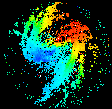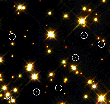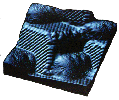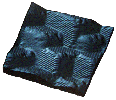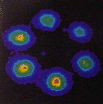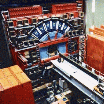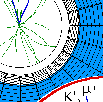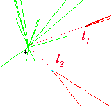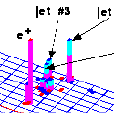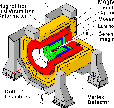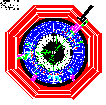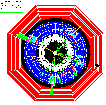Velocity field of the giant barred spiral galaxy NGC 1365, obtained with the Rutgers Fabry-Perot and the 1.5-meter telescope of the Cerro Tololo Interamerican Observatory. The colors represent velocities; due to the rotation of the galaxy, one side (shown in blue) is blueshifted relative to the center, while the other side is moving away, and redshifted (shown in red). Click here for an enlarged image. From a project of B. Weiner, T. Williams, and J. Sellwood.
Some of the longest exposures ever taken with the Hubble Space
Telescope reveal faint white dwarfs in M4, the nearest globular
cluster to earth. See the
full image (160 K), the
full caption, a
press release, and a
postscript image (480K)
showing the color-magnitude diagram for the globular cluster stars.
Contributed by C. Pryor.
Illustration of Medium Energy Ion Scattering (MEIS) from a
TiO2 (110) surface. Contributed by D. Vanderbilt.
Scanning tunneling microscope (STM) images of surface faceting on W(111)
induced by adsorption of ~1.6 atomic monolayers of Pd. Pyramids
form spontaneously with {211} facets exposed.
Contributed by C.-H. Nien and T.E. Madey.
Pattern of desorption of P atoms from PF3 molecules adsorbed on
a metal surface. Contributed by T. Madey.
The polhode rolls without slipping on the herpolhode
lying in the invariable plane!
Click the image, or see
here for an explanation and
here for a neat movie (MPEG, 451K). Contributed by J. Shapiro.
Left: the forward detectors of the CDF experiment. Right: CDF
event display showing fully reconstructed decay of a B meson to a
J/psi and a K*.
Left: detailed view of reconstructed charged tracks near the event
vertex of a top quark decay in CDF. Right: a spectacular top quark
event, with an isolated electron (lower left), and four jets. Two
of the jets come from b quarks, as evidenced by detached vertices
reconstructed with the silicon microstrip vertex detector (SVX).
Contributed by J. Conway.
Several Rutgers physicists, including Profs. Plano and
Kalelkar, are working on an experiment to make precision tests of
the Standard Model by studying polarized electron-positron
annihilations at the Stanford Linear Accelerator Center.
Left: Cutaway view of the SLD detector, which is 6 stories high
and weighs 4000 tons!
Middle: Reconstructed event in the SLD detector. An
electron-positron annihilation resulted in the creation of a quark,
an antiquark, and a gluon, giving rise to the three jets of
particles seen in the picture.
Right: A rare event in the SLD detector: quarks, antiquarks, and
gluons from an electron-positron annihilation have fragmented into
four jets of particles. The properties of such jets yield insights
into the Standard Model.
Contributed by M. Kalelkar.
Faculty and students: Please contribute more images!
Comments on this page should be mailed to
dhv@physics.rutgers.edu
